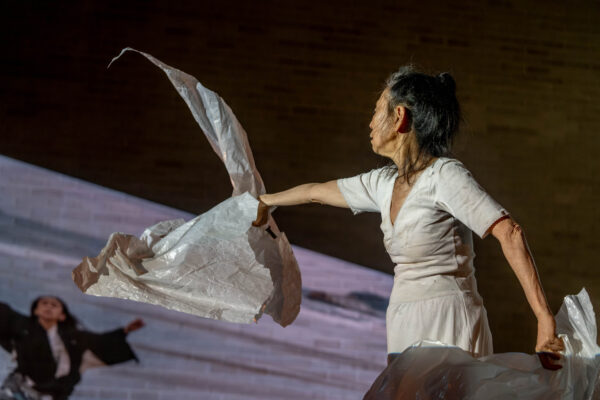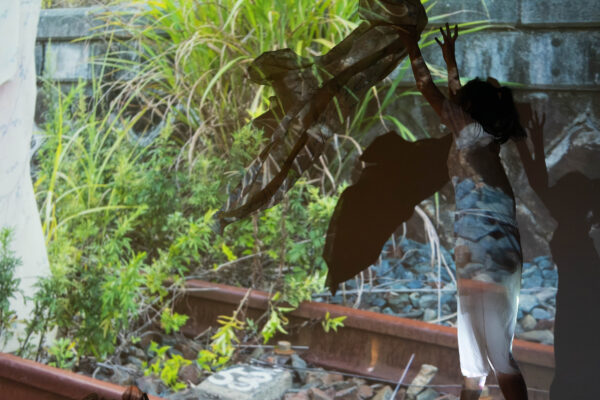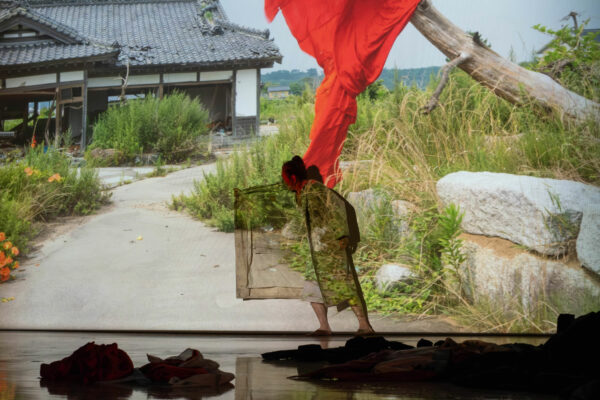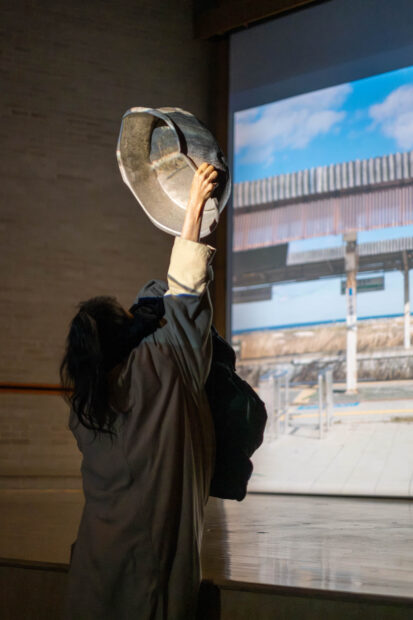Eiko Otake’s performance of A Body with Fukushima, on November 7 at the University of Houston’s Dudley Recital Hall, was intense and powerful, as its subject matter would suggest. The performance also possessed the persuasive duality of difficult subject matter reaching the viewer through a conduit of stunningly beautiful and captivating imagery.
The film component of the live event was a compilation of photographer William Johnston’s images showing Eiko Otake in the deserted ruins of land and water following the earthquake, tsunami, and subsequent disaster at the Fukushima nuclear power plant in 2011. The imagery resonated with me in the same way as Shōhei Imamura’s Black Rain, another important film dealing with the subject of devastation due to radiation. Imamura’s film chronicles the long-term effects of a toxic rain that fell from the sky in the wake of the bombing of Hiroshima. In both Black Rain and A Body in Fukushima, each scene is rendered with an aesthetic sense that makes the viewing a compelling experience, despite the magnitude of the subject matter.
In A Body in Fukushima, within each perfectly framed image, Otake’s diminutive dancer’s body sometimes commanded the space it inhabited, and sometimes it was seemingly devoured by it. Tilting off the edge of a deserted railroad platform, cocooned in kimonos in an empty station waiting room, partially emerging from a cover of vines and weeds, the images are raw and emotional, but also magnificently graceful and human.
As the film fills the stage at the Dudley Recital Hall, Otake emerges from the lobby and proceeds down the aisle, carrying bundles of fabric. At first we, the audience, are outside of the action, observing the lone figure progressing slowly toward the stage like a refugee embracing a burden she must carry. I remember seeing Eiko Otake and her longtime collaborator Koma Otake perform at the Lincoln Center Out Of Doors Festival on a beautiful New York summer night in 2011. One thousand people surrounded the Paul Milstein Reflecting Pool, where row upon row of audience members were silent and transfixed. This is how people watch Otake’s work; this recent night at the University of Houston was no exception.
As the work progresses and Otake takes the stage, a second projection of the film appears on the right wall of the concert hall. Now we, the audience, have become partially surrounded by Johnston’s images. We are inside the film as it moves to the other walls of the concert hall. As dwellers of this world that Otake has created for us, we are in and of deserted houses and streets and train stations; we are the foliage that grows unchecked and untended everywhere; we are the bags and bags of radioactive soil lined up like soldiers in an amphitheater; we are the shallow pools of water and the waves, contaminated by radiation. We are broken and hurt, but we are shepherded through by Otake’s arcing shapes. This delicately carved body standing up to the concrete ruins of demolished buildings fortifies us. She invites us to bear witness with her.
The performer merges and separates from the projected images; her clothing sometimes acts as tiny screens to show bits of images. The film shows the words “I am afraid.” As Aurora Picture Show curator Salome Kokoladze explained in her insightful pre-performance introduction, the text shown in the film uses the present tense to reflect Eiko Otake’s feelings at the time she was experiencing them. The film explains that the red cloth we see both in the film and live on stage is made from pieces of the lining of her mother’s kimonos. The fabric becomes an extension of her silhouette, encroaching on the projected imagery. Sometimes the streamer of silk presents like a flower, and other times, a striking swath of red. I think of my mother’s bracelet that I wear when I need to be brave, when I need to feel she is looking out for me as she did for all of her life. I am glad Otake has chosen to take this fabric with us into the desolate and deserted landscape.
The contemplative movements of the dancer begin to give way to sweeping motions of the arms and body that encompass the stage. In the ending section, the intensity that has been building over the course of the performance releases, comes flooding out in a series of body waves….perhaps indicative of a body in mourning, in anger, or perhaps representative of the earth sending its ocean waves to decry the injustice of man-made destruction. What’s left? A rumpled banner of paper that she pulls apart and gives to audience members in pieces. We are all a part of this narrative; we are the earth and we are the people of this story. We have heeded her call to bear witness and acknowledge that we are part of the world. And as citizens of the world, we must find solutions together.
Talking with Otake afterwards, she fields questions from audience members with humor and grace. She explains that, “as an artist, you can’t deal with everything, but you can pick something and respond.” As an artist myself, who tries to respond to events that overwhelm the world, I am so inspired by her presence, her honesty, and her bravery.
The evening began with seeing Otake standing barefoot in the lobby as the audience was still filing in. There is no wall between her and us. Eiko Otake has that magical power of presence that does not need that formality. She is here, in and of the moment, to communicate. And we who bear witness are changed.
Eiko Otake: A Body with Fukushima was co-presented by Aurora Picture Show and Cynthia Woods Mitchell Center for the Arts on November 7, 2023 at the Dudley Recital Hall at the University of Houston.







